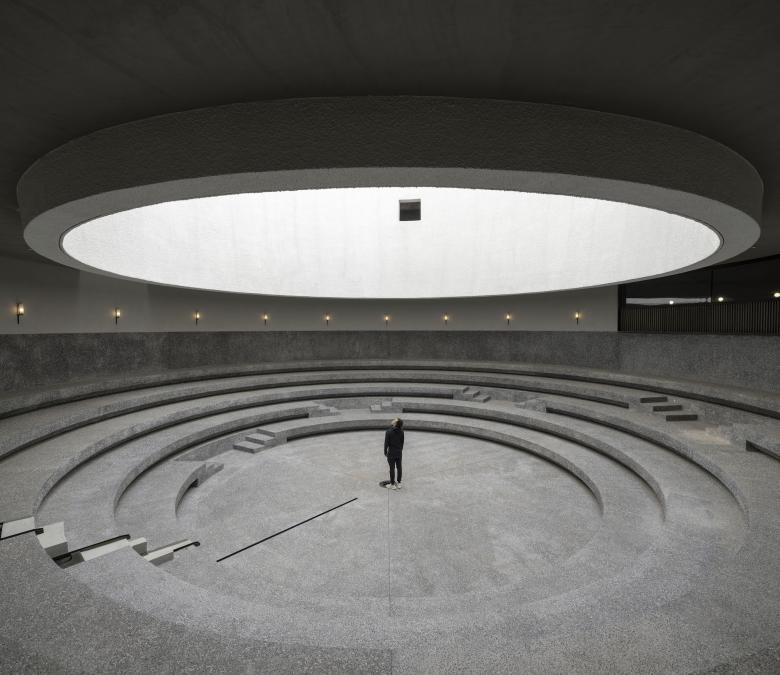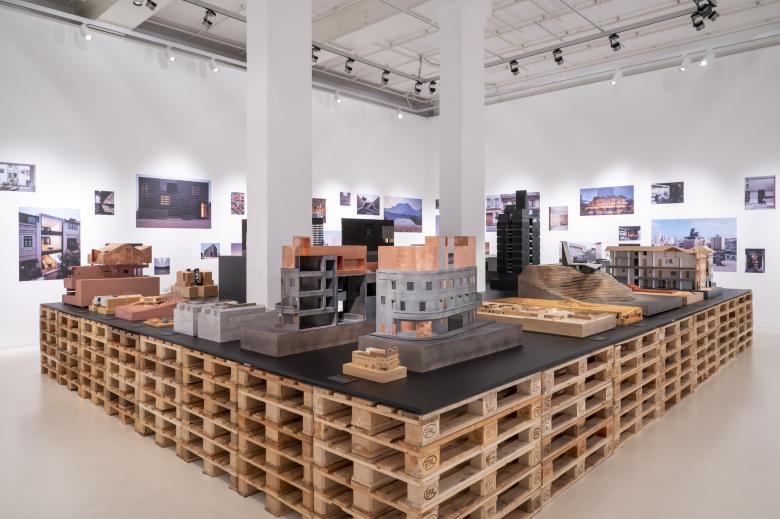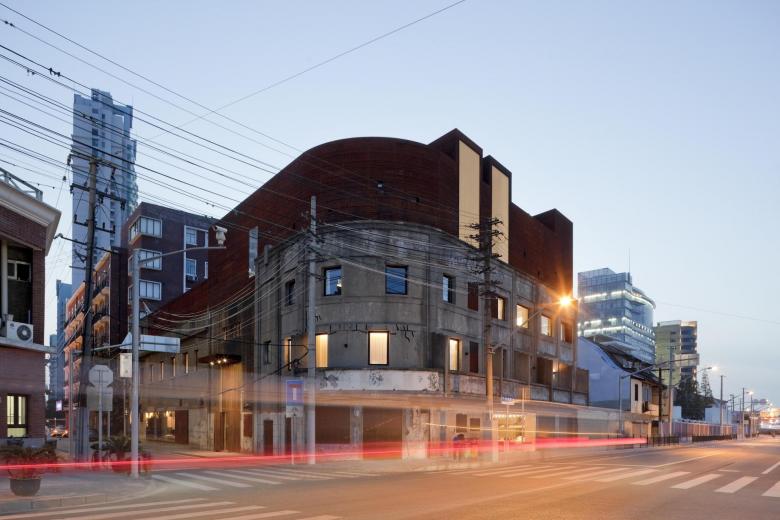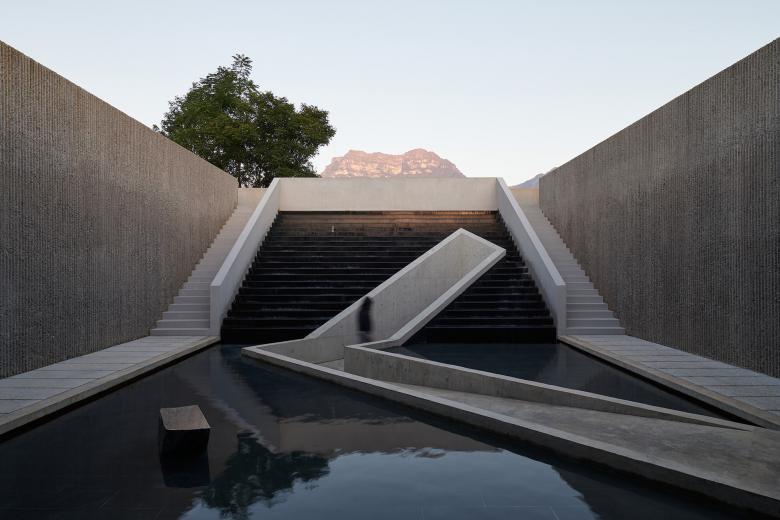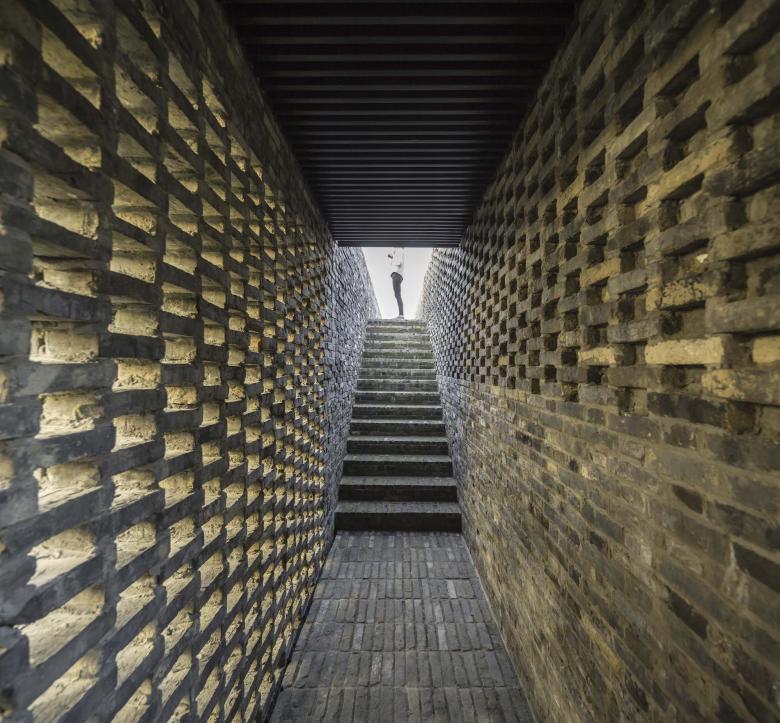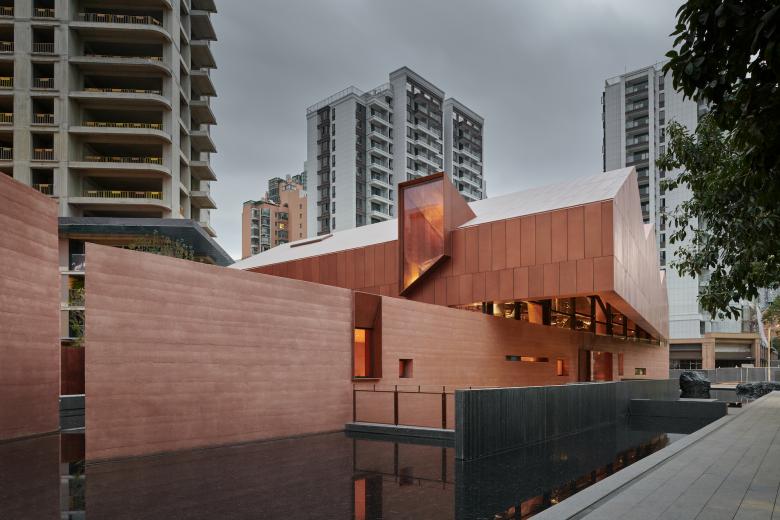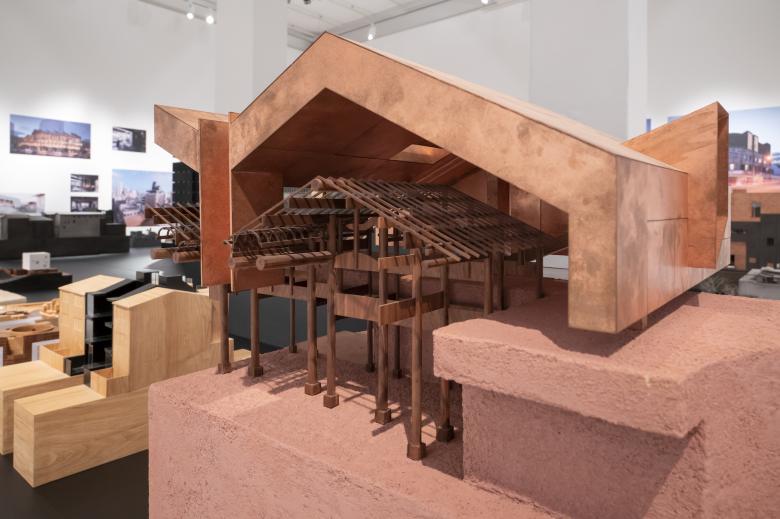Resisting the Impulse to Fix Any Flaw
Ulf Meyer
9. November 2022
Aranya Art Center (Photo © Pedro Pegenaute)
Reflective Nostalgia is an exhibition at Aedes Architecture Forum that presents the work of Neri&Hu, the Shanghai firm (with studios in London, Paris, and Milan) of Lyndon Neri and Rossana Hu. Ulf Meyer visited the Berlin gallery and sent us his impressions.
If it is true what American historian Charles Maier says, and “nostalgia is to longing what Kitsch is to art,” then the architectural office of Neri&Hu works with nostalgia — in a positive sense. One of the most interesting contemporary architectural firms in China today, Neri&Hu are demonstrating their approach and sharing their achievements with an impressive exhibition now at Aedes Gallery in Berlin (until November 30, 2022). Called Reflective Nostalgia, the show illustrates how architects Lyndon Neri and Rossana Hu sometimes keep the “charm of the old” in a project to let it “remain legible and tangible.” This is not done as a mere means to an end, but to help do away with the blurring of differences between East Asian cities that gives rise to “vast anonymous and characterless urban landscapes,” as they put it. The architects have observed, in Chinese cities in particular, that “differences and characteristics of places quickly disappear.” They want to “embrace nostalgia as a productive lens.”
Exhibition view (Photo © Erik-Jan Ouwerkerk)
There is little room between "technological progress” and “kitschy historicism” in China today, but Neri&Hu manage to avoid either trap. A good example of them finding new uses for existing buildings in a respectful manner is the Waterhouse at South Bund in Shanghai, where in 2010 they turned the former 1930s Japanese Army headquarters building into a hotel, reinterpreting found and recycled materials and adding new elements. Their reading of historical contexts ”includes all contradictions and details,” in their words, meaning that they “resisted the impulse to fix any flaw.” Located by the new Cool Docks, the Waterhouse is a 19-room boutique hotel which looks across at Pudong’s sprawling new skyline. The contrasts between old and new, smooth and textured, refined and raw are strong in the little hotel. The restored concrete building is a base for the Cor-ten steel addition whose facades resonate with the rusty ships that pass along the nearby Huangpu River.
The Waterhouse at South Bund (Photo © Derryck Menere)
Still, new buildings outnumber the conversions in Neri&Hu’s portfolio, ranging from a Christian chapel to a whisky distillery. Last year Neri&Hu completed the first whiskey distillery in China for the Pernod Ricard Corporation from France; the spectacular project is located near Mount Emei, a UNESCO World Heritage Site. The design is about the duality of shan and shui (or mountain and water). The buildings have elemental geometries grounded in the terrain. The two visitor buildings are built upon the circle and square, representing heaven and earth. The round tasting building is submerged, with five tasting rooms surrounding a domed courtyard that contains a cascading water feature. Three concentric brick rings perched atop mirror the silhouette of Mount Emei. The square restaurant and bar building is located further down, cantilevered on two sides with one corner hovering over a river bank. While the dining space is organized along the perimeter for open views, at the core an open-air courtyard is oriented to frame the Emei peak. Concrete, stone, copper, and oak form the material palette. The design strikes a nice balance between architecture and landscape, industry and visitor experience, mountain and water.
The Chuan Malt Whiskey Distillery (Photo © Chen Hao)
Equally powerful is the design of the Aranya Art Center completed at the client’s seaside resort in 2019. Behind its fortress-like exterior lies a courtyard with a water feature at its core. The scheme carves out a pure conical geometry at the center with a stepped amphitheater at the base. The central void can be filled with water or act as a performance venue. A spiraling path leads through all the spaces, guiding visitors through five galleries and culminating at the rooftop. The heavy facade is made from textured concrete with and without aggregate, while bronze elements catch light and draw attention to the entry of each gallery.
Tsingpu Yangzhou Retreat (Photo © Pedro Pegenaute)
The 20-room boutique hotel that Neri&Hu designed near Yangzhou’s Slender West Lake also works with a refined promenade architecturale. The brief called for the reuse of old buildings and addition of new ones. In order to unify the scattered elements, they overlaid a grid of walls and paths onto the site. The courtyards give hierarchy to the spaces, frame views, and encapsulate landscapes. Constructed from reclaimed grey brick, the passageways, where light plays off the brick patterns, force long perspectives. Courtyards are occupied by guest rooms, the reception, library, and restaurant and gardens. Guests can ascend through openings to look out across the landscape and the lakes. With just walls and courtyards to unify the site, Neri&Hu created rustic materiality and layered spaces.
Fuzhou Teahouse (Photo © Hao CHEN)
The exhibition at Aedes features 30 projects the office has designed since its founding in Shanghai in 2004. Documented in models, photographs, and videos, the projects reveal a delicate balance between the contrasts of new and old, smooth and textured, refined and raw, and between material contrasts and combinations of forms.
Exhibition view showing Fuzhou Teahouse (Photo © Erik-Jan Ouwerkerk)
Related articles
-
Resisting the Impulse to Fix Any Flaw
on 11/9/22
-
Junshan Cultural Center
on 3/20/20
-
A Screen Into Junshan
on 3/17/20
-
The HUB Performance and Exhibition Center
on 8/24/17
-
Chapel by the Lake
on 6/1/17
